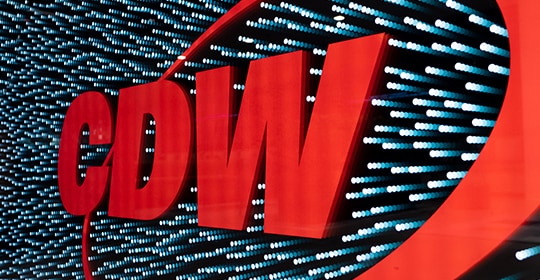Research everything IT
1 - 24 of 365
Sort By:
View:
Mar 29, 2024
Digital Workspace
Demystifying Artificial Intelligence Adoption for Your Organization
Article
3 min
When it comes to adopting artificial intelligence to optimize your organization, it’s all about developing a strategic plan first, then incorporating new technology and processes to benefit your workforce and customers.
Mar 29, 2024
Digital Workspace
Prepared for a Bright Future with a Robust Digital Transformation Journey
Case Study
9 min
CDW’s ambitious modernization project not only transformed its technology stack but also empowered team members and streamlined processes.
Mar 15, 2024
Digital Workspace
Interoperability: The Key to Streamlining Federal IT Systems
Article
3 min
Federal governments must streamline collaboration to meet the demands of the technological landscape. Interoperability can help you keep up with the demands of the time.
Mar 05, 2024
Digital Workspace
How Federal Agencies Can Provide an Optimal Digital Experience
White Paper
15 min
To optimize the digital experience, agencies must consider the needs of both remote and in-office workers.
Mar 01, 2024
Digital Workspace
3 Advantages of Modern Endpoint Device Management
Article
3 min
Modern endpoint device management means embracing new ways of doing business that are effective and secure. It can not only cut costs in the long run, but also empower your IT staff to work smarter.
Mar 01, 2024
Digital Workspace
3 Helpful Tips to Guide Your Conversation with a Managed Collaboration Provider
Article
3 min
If your collaborative services are set to expire soon, it would be beneficial to prepare for a discussion with your provider using these three useful tips.
Feb 29, 2024
Digital Workspace
3 Ways AI Can Improve Your Retail Customer Experience
Article
3 min
To optimize your organization’s customer experience — which should always be a top priority — consider investing in artificial intelligence technologies that can make your customers and employees happier and cut costs in the long run.
Feb 16, 2024
Digital Workspace
Citizens First: Modernization With a Human-Centered Design
Article
3 min
State and local agencies looking to modernize their services can benefit greatly from the human-centered design methodology.
Feb 15, 2024
Digital Workspace
How Windows Autopilot Can Streamline New Device Deployments
Article
4 min
By automating setup and configuration tasks, this Microsoft tool can deliver a better experience for both IT teams and users.
Feb 08, 2024
Digital Workspace
Modernizing the Retail Customer Experience
White Paper
12 min
Best practices and best-in-class technologies can help retailers delight their customers and create a competitive edge.
Feb 07, 2024
Digital Workspace
Optimizing Outcomes as Connected Care Evolves
White Paper
12 min
By connecting technologies across workflows, healthcare providers can improve the experiences of patients and clinicians.
Feb 06, 2024
Digital Workspace
TCEA 2024: Esports Boosts Attendance and Academic Performance in Schools
Article
3 min
K–12 educators are using varsity- and club-level esports programs to engage students and create a sense of belonging.
Jan 26, 2024
Digital Workspace
3 Questions to Ask Before Migrating Workloads to the Cloud
Article
3 min
Migrating your workload to the cloud is an important step in modern business — and establishing security and governance foundations in advance will help your migration be safe and successful.
Jan 12, 2024
Digital Workspace
3 Trends in Healthcare Contact Centers to Improve Patient Experience
Article
3 min
Healthcare facilities must do everything they can to ensure excellent patient experiences — and having a strong, unified contact center can differentiate them from the competition.
Dec 22, 2023
Digital Workspace
3 Technology Trends That Are Improving Hybrid Work
Article
4 min
Find success with hybrid work by weaving key technology into your long-term strategy, such as Software as a Service, edge computing and artificial intelligence.
Nov 17, 2023
Digital Workspace
3 Ways a Contact Center Boosts Customer Experience in Your Financial Institution
Article
3 min
Your financial institution can benefit from a contact center in several key ways, laying the foundation to automate time-consuming tasks so that your employees are empowered to enhance the overall customer experience.
Nov 07, 2023
Digital Workspace
Improve Collaboration in the Public Sector With Cisco Solutions
White Paper
6 min
From the enterprise to the tactical edge, Cisco's UC Manager solution is an industry leader in enterprise call and session management platforms for federal agencies.
Oct 18, 2023
Digital Workspace
Four Keys to Supporting ‘Deskless’ Frontline Workers with ChromeOS
Article
3 min
Organizations need devices designed to meet the unique needs of their employees.
Oct 16, 2023
Digital Workspace
Tech Tips for a Successful School Year
Article
5 min
Get tips on how you can use technology to expand extracurricular programs, improve digital literacy, better manage safety and security, and ultimately create a more supportive school environment.
Oct 06, 2023
Digital Workspace
3 Keys for a Unified Approach to a Better Modern Workspace
Article
3 min
To get to a better modern workspace, your organization should invest in the tools and practices that allow for secure, seamless collaboration and productivity, no matter where your employees work from.
Oct 02, 2023
Digital Workspace
Virtual Reality vs. Augmented Reality vs. Mixed Reality
Article
3 min
This article delves into the differences and similarities between VR, AR and MR, allowing for a better understanding of their applications and potential use cases.
Sep 30, 2023
Digital Workspace
3 Parts of a University That Should Have a Contact Center
Article
3 min
Introducing a contact center in key areas of your university is a savvy decision that can enhance the incoming student experience, build better rapport with alumni and improve the process of purchasing tickets to sporting events.
Sep 08, 2023
Digital Workspace
Beyond IT: Five Unexpected Ways to Utilize ServiceNow
Article
3 min
Organizations that use ServiceNow only for IT service management are missing out on key capabilities.
Aug 31, 2023
Digital Workspace
How a Midsized Bank Leveraged Technology to Modernize Its Workflows
Case Study
6 min
With help from CDW, the institution deployed ServiceNow to update and simplify a range of processes, with more ambitious modernization projects in the works.
























